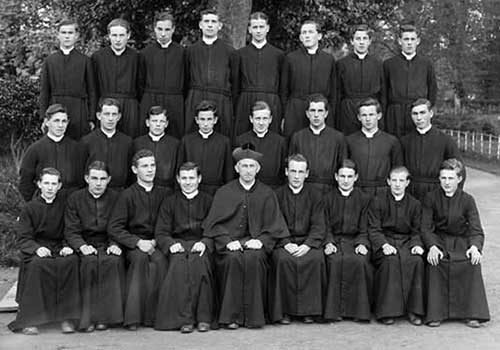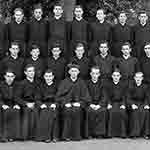
It happens a lot. I use a tree to illustrate the wood (forest), and people focus on the particular tree. Sometimes the particular tree is actually worth focusing on. This tree, I think, is worth its own look.
The question that I am now interested in is: where and in what contexts are clergy wearing a cassock or a soutane?
There’s been a post doing the facebook rounds: A cassock: Work clothes, not a dress uniform
The first day he put on a cassock, a seminarian got a letter from a friend, a few years his senior. This is what he learned about his cassock:
A cassock. Today in your eyes it is more beautiful than a bride’s dress. You are truly and rightfully happy wearing it; after all, you have been waiting for it since the time you entered the seminary.
I can only hope that you will be equally happy when it has come to be what its color implies, i.e. a deadly shroud and a dying uniform. Today it is a bride’s dress you enthuse over, along with your family and friends. Be as enthusiastic about it when it starts to be your solitary confinement, cage and furnace where God will melt and purify you, an uncomfortable hermitage.
This bride’s dress, when necessary, will be your armor, provided you care to remember and use it this way. Wearing a cassock can and should be a form of prayer in itself, but it does not become a prayer just by putting it on.
Pockets. The deep ones are meant to store all the things you will share with others. Always have something to give away to the needy and children. Remember that they will appreciate a little money, your smile, and a word of solace more than your impeccable hymn singing. This is because people need first and foremost to hear that they are loved, and even more so to feel that this is true.
An inside breast pocket. It is not meant for holding an expensive pen. Carry in it letters you do not know how to answer, notes with the names of those you have promised to pray for, other people’s bills you have decided to pay, addresses you know should be visited, as their occupants will never come to you on their own, pictures of dogs, cats, grandchildren, and people in love as well as tree leaves and drawings nursery students have offered you. Keep this pocket filled at all times…. [read on about this]
What interests me, in conversations around this, is – where (and when) are clergy wearing a cassock (or soutane) in public? (ie. other than in church environment). Do let us know in the comments.
Some of the discussion around this (that led to this post) indicated that wearing a cassock is common (at least in some places) in Tikanga Maori. Where else does it occur?
If you appreciated this post, do remember to like the liturgy facebook page, use the RSS feed, and sign up for a not-very-often email, …
Photo credit: National Library of Ireland on The Commons via Foter.com / No known copyright restrictions




Much as I am not very keen on thought of wearing a cassock everyday, I acknowledge an Orthodox commenter on my blog who has pointed out that Orthodox clergy wear a habit (is that right term?) everyday and all day, thus bearing witness to Christ in a distinctive manner and thus advertising pastoral availability in a highly visible way in the local community.
Thanks, Peter. The clerical collar also functions in the manner you describe. Blessings.
I love to see clergy in their cassocks. A good friend of mine wears his when out and about, and since he ministers in a now largely Muslim neighbourhood, he fits right in with the locals! (There’s a Macedonian Orthodox parish across the street from his Anglican one, and the priest there wears his cassock too.)
There’s a nice story on Wikipedia about the actor Alec Guinness’s experience of wearing a cassock, and what it led to:
“While serving in the Royal Navy, Guinness had planned to become an Anglican priest. In 1954, while he was filming Father Brown in Burgundy, Guinness, who was in costume as a Catholic priest, was mistaken for a real priest by a local child. Guinness was far from fluent in French, and the child apparently did not notice that Guinness did not understand him but took his hand and chattered while the two strolled; the child then waved and trotted off. The confidence and affection the clerical attire appeared to inspire in the boy left a deep impression on the actor. When their son was ill with polio at the age of 11, Guinness began visiting a church to pray. A few years later in 1956, Guinness converted to the Roman Catholic Church.”
My Latin teacher in high school was a retired Anglican priest (and missionary medical doctor). He told a funny story about how as a seminarian he was so assiduous in attending Morning Prayer that his friends decided to play a prank on him to stop him from going. While he was sleeping, they snuck into his room and stole all his trousers. Imagine their surprise when they saw him at Morning Prayer the next day… in his cassock. 🙂
Yes, Jesse. But I have also had the opposite effect – because of the high profile of church sex-abuse. I tend to wear clerical attire more than not. Regularly, it has led to very positive encounters. But occasionally it has resulted in strong negative reaction – to the point of threats of violence. I have managed, thankfully, in most of those occasions to engage in a conversation where I have made clear how distressed I am that the trusted position of clergy has been so gravely misused. Blessings.
I wear my cassock six days a week. The only day I don’t wear it is on my rest day. I’ve been everywhere in it, not just church. I wear it to shops, pubs, restaurants, on public transport. To me it is important to show incredibly clearly what I am. A clerical collar can be obscured by having to wear a coat or a scarf. The cassock is unmistakable and unmissable. Wearing it has lead to many encounters on the street, I’ve prayed for people, been asked to bless people and even heard confession. It displays clearly that I’m present.
Thanks, Fr Sam. Great to have your comment about this here. Blessings.
Have often pondered clerical collars etc since I work full-time as an accountant/business advisor and yet am also a Priest.
And use of Rev.
Thanks, Gendi. What has your pondering led to? Blessings.
On the “dress uniform” side of things, the vice principal of my theological college once told us “a cassock is always respectable”, so I always wear a cassock on occasions where “formal dress” is required.
I do not wear a suit, either with tie or clerical collar. I do possess a suit, which belonged to my father-in-law who died 35 years ago, but have not worn it since I was ordained as an Orthodox deacon 13 years ago.
I wear a cassock in public when I am going out on church business, but not when I’m going shopping. The latter may be OK in countries like Greece or Russia, but in South Africa it is more likely to make petrol pump attendants greet me with “Salaam Aleikum”.
Thanks, Deacon Stephen, for your helpful points about context. Blessings.
I wouldn’t say it’s overly common in Tikanga Maori, but I certainly see more Maori clerics in Cassocks than I do Tikanga Pakeha Clerics.
I wonder if this is because often times events Maori clerics attend (whether they’re taking karakia or not) are rather ceremonial? For example the wearing of cassocks to powhiri. Wearing them around the Marae etc. That’s pretty common. But I don’t know any Maori clerics who wear the cassock daily as a uniform or “regular” clothes.
Kia ora, Christopher. Thanks for the expansion and clarification. Nga manaakitanga.
If I am going to be wearing the cassock liturgically I wear it travelling to and from church, unless I have some reason (a meeting for example) not to, which is very rare. So, in Liverpool that is walking to St Agnes, Ullet Rd. Also on trains, buses, the tube in London etc. It is a strong sign but I have never had anything but good reactions and conversations resulting from it in. frequent requests for prayer and occasional requests for photos posed with me.
Thanks, Fr Richard. That brings up another point: there are those who would always/generally/often wear a cassock under the alb when presiding. Blessings.
Perhaps I ought to qualify what I said above by saying that I do much the same. When I said I don’t wear a cassock when shopping, I meant that I don’t put on a cassock just to go to the shop. But if I stop at the shop on the way home from church I’ll probably be wearing it.
Concerning the way people respond, you might like this: Manic street preachers | Khanya
In Canada, it would be very unusual for Anglican Clergy to wear a cassock “out and about.” I drive to graveside services while wearing my cassock, or I am driven by the funeral home. I have heard stories from “the old days” on clergy wearing cassocks when making parish visits, but that would be in the 1950’s or earlier. Our issue tends to be the wearing of the collar. I find that the collar opens doors to wonderful random conversations in coffee shops, grocery stores etc. I have also met people who have responded to me out of their trauma of abuse at the hands of clergy.
Thanks, Peter, for specifying your context. You describe what is my own experience also. A lot of people here (rightly IMO) have a very negative image of religion/Christianity/Church, and with that of God/Jesus/Bible. I’m conscious that I might help shift that even if only slightly; even if only towards a more neutral/open place. Blessings.
What I find interesting is that today, most men who wear a cassock, also wear dress trousers under them. Since the cassock is a full outwear garmet, why not just an undershirt and boxers?
They certainly cover more than a kilt!
My understanding, David, is that a cassock is a (full length) coat (the coat being shortened to a jacket more recently). So that one wears trousers under it does not surprise me. It is not a lengthy kilt. Blessings.